Design and Development of IT Solutions, Globalisation & Infrastructure
VerifiedAdded on 2023/06/14
|11
|3266
|461
Report
AI Summary
This report provides a comprehensive analysis of IT solutions, focusing on design theories, development methods, and the impact of globalisation. It examines the design and implementation of IT solutions like Canvas and MS Word, discussing the concept and process of management information networks and administrative support systems. The report explores the effects of globalisation on IT, highlighting the importance of IT infrastructure in digital transformation. It also defines and discusses the advantages and disadvantages of digital infrastructure, along with the risks associated with information systems outsourcing. Different systems like DSS, ESS, TPS, MIS and KMS are also described with relevant examples.

4005 2
Paraphrase This Document
Need a fresh take? Get an instant paraphrase of this document with our AI Paraphraser
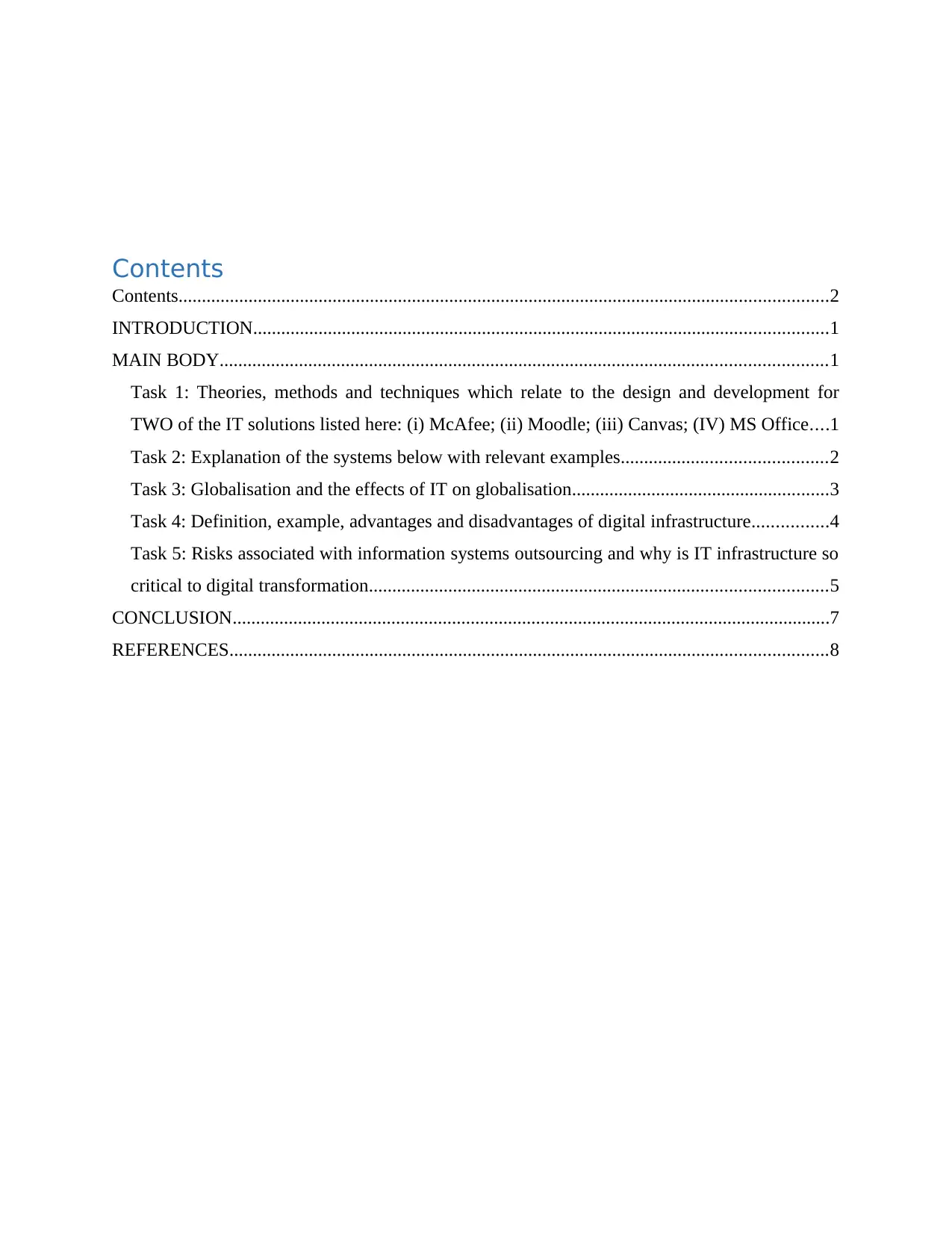
Contents
Contents...........................................................................................................................................2
INTRODUCTION...........................................................................................................................1
MAIN BODY..................................................................................................................................1
Task 1: Theories, methods and techniques which relate to the design and development for
TWO of the IT solutions listed here: (i) McAfee; (ii) Moodle; (iii) Canvas; (IV) MS Office....1
Task 2: Explanation of the systems below with relevant examples............................................2
Task 3: Globalisation and the effects of IT on globalisation.......................................................3
Task 4: Definition, example, advantages and disadvantages of digital infrastructure................4
Task 5: Risks associated with information systems outsourcing and why is IT infrastructure so
critical to digital transformation..................................................................................................5
CONCLUSION................................................................................................................................7
REFERENCES................................................................................................................................8
Contents...........................................................................................................................................2
INTRODUCTION...........................................................................................................................1
MAIN BODY..................................................................................................................................1
Task 1: Theories, methods and techniques which relate to the design and development for
TWO of the IT solutions listed here: (i) McAfee; (ii) Moodle; (iii) Canvas; (IV) MS Office....1
Task 2: Explanation of the systems below with relevant examples............................................2
Task 3: Globalisation and the effects of IT on globalisation.......................................................3
Task 4: Definition, example, advantages and disadvantages of digital infrastructure................4
Task 5: Risks associated with information systems outsourcing and why is IT infrastructure so
critical to digital transformation..................................................................................................5
CONCLUSION................................................................................................................................7
REFERENCES................................................................................................................................8

⊘ This is a preview!⊘
Do you want full access?
Subscribe today to unlock all pages.

Trusted by 1+ million students worldwide
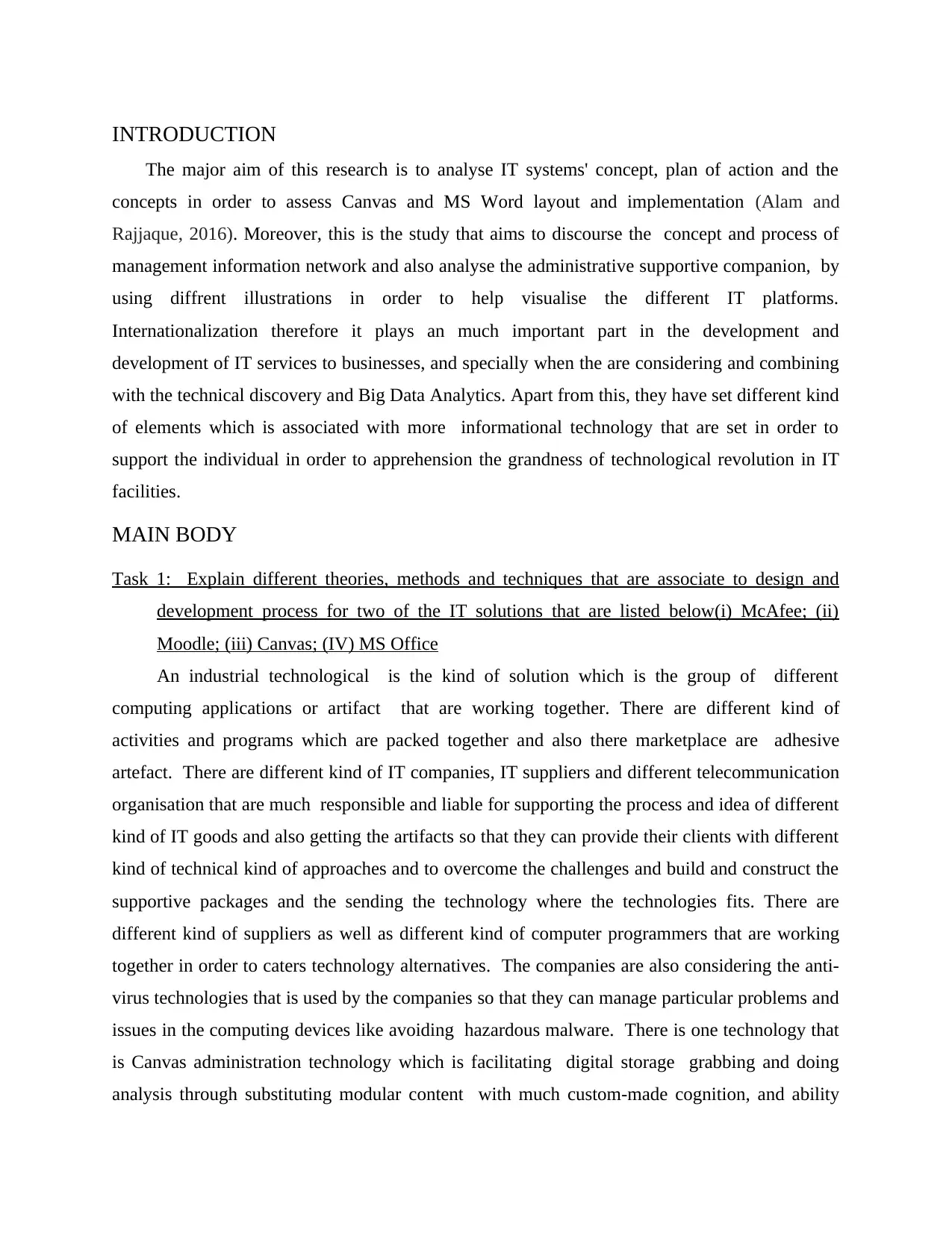
INTRODUCTION
The major aim of this research is to analyse IT systems' concept, plan of action and the
concepts in order to assess Canvas and MS Word layout and implementation (Alam and
Rajjaque, 2016). Moreover, this is the study that aims to discourse the concept and process of
management information network and also analyse the administrative supportive companion, by
using diffrent illustrations in order to help visualise the different IT platforms.
Internationalization therefore it plays an much important part in the development and
development of IT services to businesses, and specially when the are considering and combining
with the technical discovery and Big Data Analytics. Apart from this, they have set different kind
of elements which is associated with more informational technology that are set in order to
support the individual in order to apprehension the grandness of technological revolution in IT
facilities.
MAIN BODY
Task 1: Explain different theories, methods and techniques that are associate to design and
development process for two of the IT solutions that are listed below(i) McAfee; (ii)
Moodle; (iii) Canvas; (IV) MS Office
An industrial technological is the kind of solution which is the group of different
computing applications or artifact that are working together. There are different kind of
activities and programs which are packed together and also there marketplace are adhesive
artefact. There are different kind of IT companies, IT suppliers and different telecommunication
organisation that are much responsible and liable for supporting the process and idea of different
kind of IT goods and also getting the artifacts so that they can provide their clients with different
kind of technical kind of approaches and to overcome the challenges and build and construct the
supportive packages and the sending the technology where the technologies fits. There are
different kind of suppliers as well as different kind of computer programmers that are working
together in order to caters technology alternatives. The companies are also considering the anti-
virus technologies that is used by the companies so that they can manage particular problems and
issues in the computing devices like avoiding hazardous malware. There is one technology that
is Canvas administration technology which is facilitating digital storage grabbing and doing
analysis through substituting modular content with much custom-made cognition, and ability
The major aim of this research is to analyse IT systems' concept, plan of action and the
concepts in order to assess Canvas and MS Word layout and implementation (Alam and
Rajjaque, 2016). Moreover, this is the study that aims to discourse the concept and process of
management information network and also analyse the administrative supportive companion, by
using diffrent illustrations in order to help visualise the different IT platforms.
Internationalization therefore it plays an much important part in the development and
development of IT services to businesses, and specially when the are considering and combining
with the technical discovery and Big Data Analytics. Apart from this, they have set different kind
of elements which is associated with more informational technology that are set in order to
support the individual in order to apprehension the grandness of technological revolution in IT
facilities.
MAIN BODY
Task 1: Explain different theories, methods and techniques that are associate to design and
development process for two of the IT solutions that are listed below(i) McAfee; (ii)
Moodle; (iii) Canvas; (IV) MS Office
An industrial technological is the kind of solution which is the group of different
computing applications or artifact that are working together. There are different kind of
activities and programs which are packed together and also there marketplace are adhesive
artefact. There are different kind of IT companies, IT suppliers and different telecommunication
organisation that are much responsible and liable for supporting the process and idea of different
kind of IT goods and also getting the artifacts so that they can provide their clients with different
kind of technical kind of approaches and to overcome the challenges and build and construct the
supportive packages and the sending the technology where the technologies fits. There are
different kind of suppliers as well as different kind of computer programmers that are working
together in order to caters technology alternatives. The companies are also considering the anti-
virus technologies that is used by the companies so that they can manage particular problems and
issues in the computing devices like avoiding hazardous malware. There is one technology that
is Canvas administration technology which is facilitating digital storage grabbing and doing
analysis through substituting modular content with much custom-made cognition, and ability
Paraphrase This Document
Need a fresh take? Get an instant paraphrase of this document with our AI Paraphraser
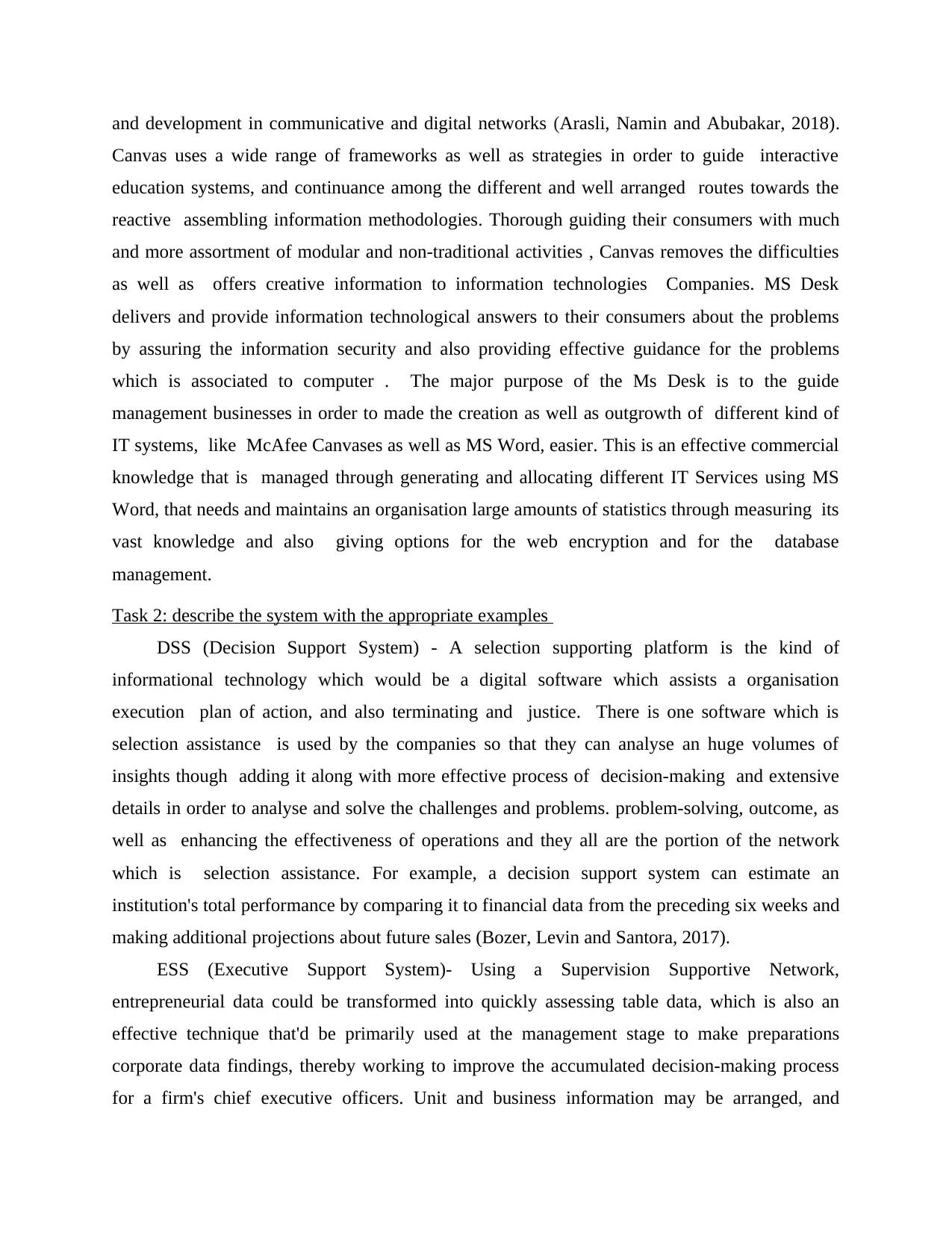
and development in communicative and digital networks (Arasli, Namin and Abubakar, 2018).
Canvas uses a wide range of frameworks as well as strategies in order to guide interactive
education systems, and continuance among the different and well arranged routes towards the
reactive assembling information methodologies. Thorough guiding their consumers with much
and more assortment of modular and non-traditional activities , Canvas removes the difficulties
as well as offers creative information to information technologies Companies. MS Desk
delivers and provide information technological answers to their consumers about the problems
by assuring the information security and also providing effective guidance for the problems
which is associated to computer . The major purpose of the Ms Desk is to the guide
management businesses in order to made the creation as well as outgrowth of different kind of
IT systems, like McAfee Canvases as well as MS Word, easier. This is an effective commercial
knowledge that is managed through generating and allocating different IT Services using MS
Word, that needs and maintains an organisation large amounts of statistics through measuring its
vast knowledge and also giving options for the web encryption and for the database
management.
Task 2: describe the system with the appropriate examples
DSS (Decision Support System) - A selection supporting platform is the kind of
informational technology which would be a digital software which assists a organisation
execution plan of action, and also terminating and justice. There is one software which is
selection assistance is used by the companies so that they can analyse an huge volumes of
insights though adding it along with more effective process of decision-making and extensive
details in order to analyse and solve the challenges and problems. problem-solving, outcome, as
well as enhancing the effectiveness of operations and they all are the portion of the network
which is selection assistance. For example, a decision support system can estimate an
institution's total performance by comparing it to financial data from the preceding six weeks and
making additional projections about future sales (Bozer, Levin and Santora, 2017).
ESS (Executive Support System)- Using a Supervision Supportive Network,
entrepreneurial data could be transformed into quickly assessing table data, which is also an
effective technique that'd be primarily used at the management stage to make preparations
corporate data findings, thereby working to improve the accumulated decision-making process
for a firm's chief executive officers. Unit and business information may be arranged, and
Canvas uses a wide range of frameworks as well as strategies in order to guide interactive
education systems, and continuance among the different and well arranged routes towards the
reactive assembling information methodologies. Thorough guiding their consumers with much
and more assortment of modular and non-traditional activities , Canvas removes the difficulties
as well as offers creative information to information technologies Companies. MS Desk
delivers and provide information technological answers to their consumers about the problems
by assuring the information security and also providing effective guidance for the problems
which is associated to computer . The major purpose of the Ms Desk is to the guide
management businesses in order to made the creation as well as outgrowth of different kind of
IT systems, like McAfee Canvases as well as MS Word, easier. This is an effective commercial
knowledge that is managed through generating and allocating different IT Services using MS
Word, that needs and maintains an organisation large amounts of statistics through measuring its
vast knowledge and also giving options for the web encryption and for the database
management.
Task 2: describe the system with the appropriate examples
DSS (Decision Support System) - A selection supporting platform is the kind of
informational technology which would be a digital software which assists a organisation
execution plan of action, and also terminating and justice. There is one software which is
selection assistance is used by the companies so that they can analyse an huge volumes of
insights though adding it along with more effective process of decision-making and extensive
details in order to analyse and solve the challenges and problems. problem-solving, outcome, as
well as enhancing the effectiveness of operations and they all are the portion of the network
which is selection assistance. For example, a decision support system can estimate an
institution's total performance by comparing it to financial data from the preceding six weeks and
making additional projections about future sales (Bozer, Levin and Santora, 2017).
ESS (Executive Support System)- Using a Supervision Supportive Network,
entrepreneurial data could be transformed into quickly assessing table data, which is also an
effective technique that'd be primarily used at the management stage to make preparations
corporate data findings, thereby working to improve the accumulated decision-making process
for a firm's chief executive officers. Unit and business information may be arranged, and
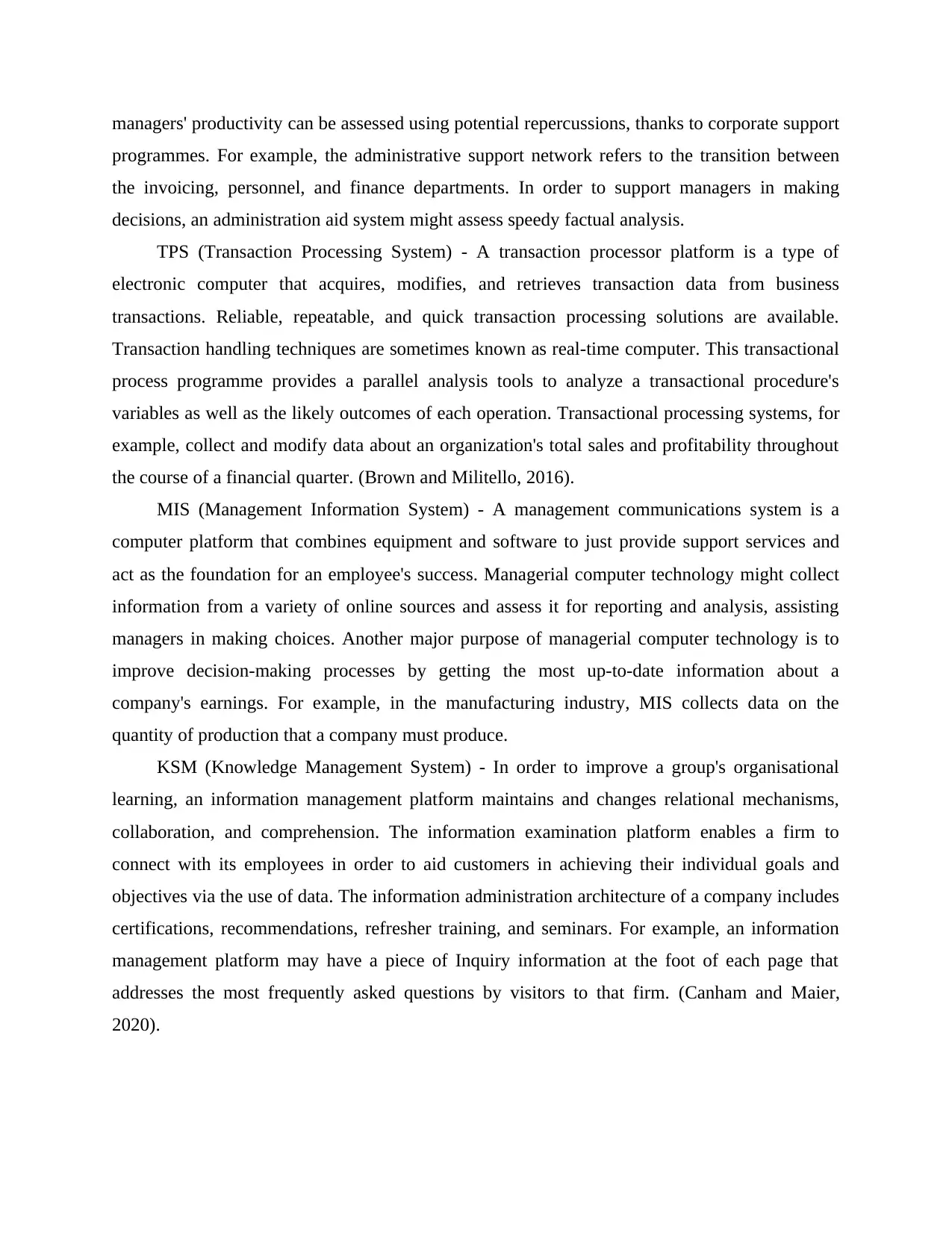
managers' productivity can be assessed using potential repercussions, thanks to corporate support
programmes. For example, the administrative support network refers to the transition between
the invoicing, personnel, and finance departments. In order to support managers in making
decisions, an administration aid system might assess speedy factual analysis.
TPS (Transaction Processing System) - A transaction processor platform is a type of
electronic computer that acquires, modifies, and retrieves transaction data from business
transactions. Reliable, repeatable, and quick transaction processing solutions are available.
Transaction handling techniques are sometimes known as real-time computer. This transactional
process programme provides a parallel analysis tools to analyze a transactional procedure's
variables as well as the likely outcomes of each operation. Transactional processing systems, for
example, collect and modify data about an organization's total sales and profitability throughout
the course of a financial quarter. (Brown and Militello, 2016).
MIS (Management Information System) - A management communications system is a
computer platform that combines equipment and software to just provide support services and
act as the foundation for an employee's success. Managerial computer technology might collect
information from a variety of online sources and assess it for reporting and analysis, assisting
managers in making choices. Another major purpose of managerial computer technology is to
improve decision-making processes by getting the most up-to-date information about a
company's earnings. For example, in the manufacturing industry, MIS collects data on the
quantity of production that a company must produce.
KSM (Knowledge Management System) - In order to improve a group's organisational
learning, an information management platform maintains and changes relational mechanisms,
collaboration, and comprehension. The information examination platform enables a firm to
connect with its employees in order to aid customers in achieving their individual goals and
objectives via the use of data. The information administration architecture of a company includes
certifications, recommendations, refresher training, and seminars. For example, an information
management platform may have a piece of Inquiry information at the foot of each page that
addresses the most frequently asked questions by visitors to that firm. (Canham and Maier,
2020).
programmes. For example, the administrative support network refers to the transition between
the invoicing, personnel, and finance departments. In order to support managers in making
decisions, an administration aid system might assess speedy factual analysis.
TPS (Transaction Processing System) - A transaction processor platform is a type of
electronic computer that acquires, modifies, and retrieves transaction data from business
transactions. Reliable, repeatable, and quick transaction processing solutions are available.
Transaction handling techniques are sometimes known as real-time computer. This transactional
process programme provides a parallel analysis tools to analyze a transactional procedure's
variables as well as the likely outcomes of each operation. Transactional processing systems, for
example, collect and modify data about an organization's total sales and profitability throughout
the course of a financial quarter. (Brown and Militello, 2016).
MIS (Management Information System) - A management communications system is a
computer platform that combines equipment and software to just provide support services and
act as the foundation for an employee's success. Managerial computer technology might collect
information from a variety of online sources and assess it for reporting and analysis, assisting
managers in making choices. Another major purpose of managerial computer technology is to
improve decision-making processes by getting the most up-to-date information about a
company's earnings. For example, in the manufacturing industry, MIS collects data on the
quantity of production that a company must produce.
KSM (Knowledge Management System) - In order to improve a group's organisational
learning, an information management platform maintains and changes relational mechanisms,
collaboration, and comprehension. The information examination platform enables a firm to
connect with its employees in order to aid customers in achieving their individual goals and
objectives via the use of data. The information administration architecture of a company includes
certifications, recommendations, refresher training, and seminars. For example, an information
management platform may have a piece of Inquiry information at the foot of each page that
addresses the most frequently asked questions by visitors to that firm. (Canham and Maier,
2020).
⊘ This is a preview!⊘
Do you want full access?
Subscribe today to unlock all pages.

Trusted by 1+ million students worldwide
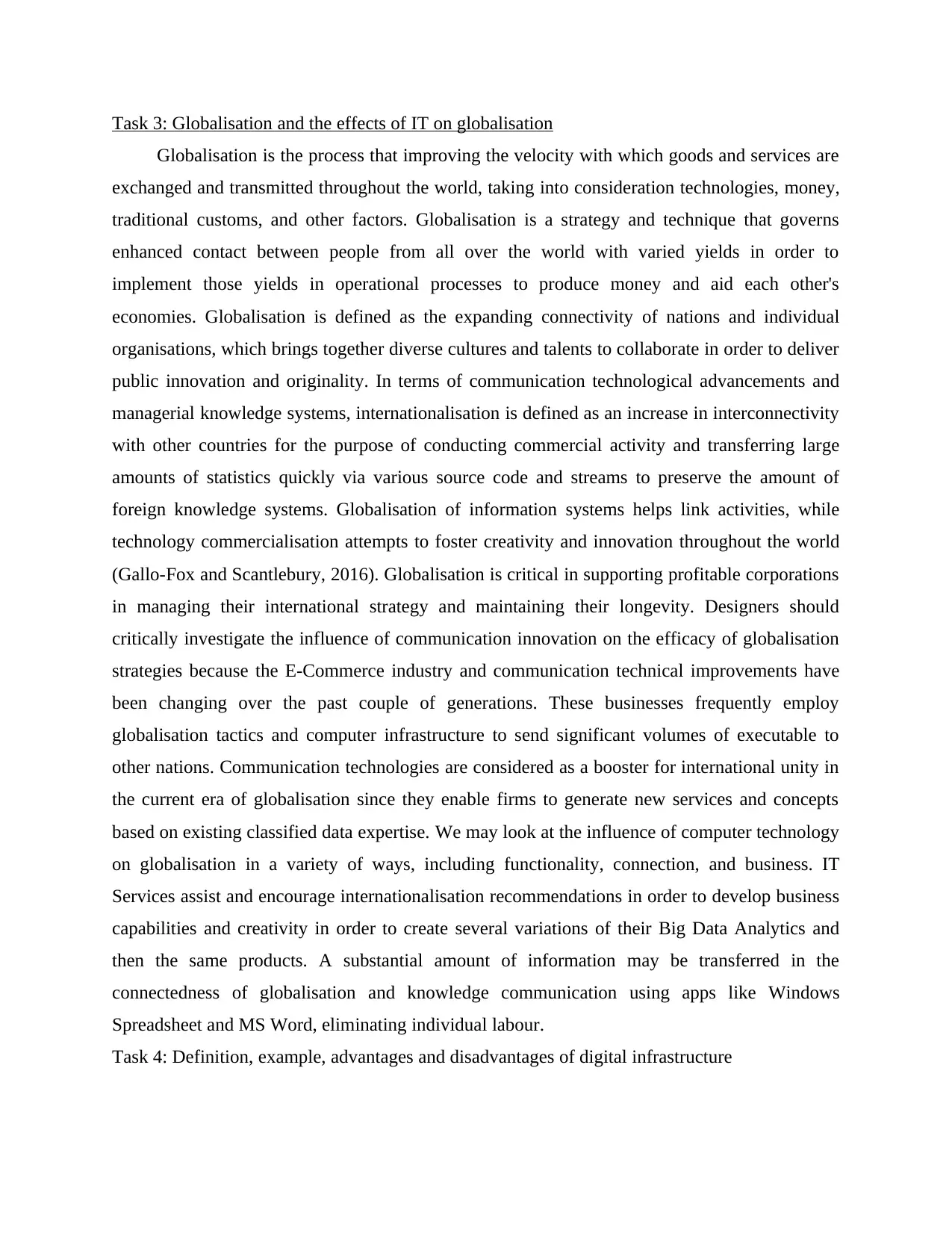
Task 3: Globalisation and the effects of IT on globalisation
Globalisation is the process that improving the velocity with which goods and services are
exchanged and transmitted throughout the world, taking into consideration technologies, money,
traditional customs, and other factors. Globalisation is a strategy and technique that governs
enhanced contact between people from all over the world with varied yields in order to
implement those yields in operational processes to produce money and aid each other's
economies. Globalisation is defined as the expanding connectivity of nations and individual
organisations, which brings together diverse cultures and talents to collaborate in order to deliver
public innovation and originality. In terms of communication technological advancements and
managerial knowledge systems, internationalisation is defined as an increase in interconnectivity
with other countries for the purpose of conducting commercial activity and transferring large
amounts of statistics quickly via various source code and streams to preserve the amount of
foreign knowledge systems. Globalisation of information systems helps link activities, while
technology commercialisation attempts to foster creativity and innovation throughout the world
(Gallo-Fox and Scantlebury, 2016). Globalisation is critical in supporting profitable corporations
in managing their international strategy and maintaining their longevity. Designers should
critically investigate the influence of communication innovation on the efficacy of globalisation
strategies because the E-Commerce industry and communication technical improvements have
been changing over the past couple of generations. These businesses frequently employ
globalisation tactics and computer infrastructure to send significant volumes of executable to
other nations. Communication technologies are considered as a booster for international unity in
the current era of globalisation since they enable firms to generate new services and concepts
based on existing classified data expertise. We may look at the influence of computer technology
on globalisation in a variety of ways, including functionality, connection, and business. IT
Services assist and encourage internationalisation recommendations in order to develop business
capabilities and creativity in order to create several variations of their Big Data Analytics and
then the same products. A substantial amount of information may be transferred in the
connectedness of globalisation and knowledge communication using apps like Windows
Spreadsheet and MS Word, eliminating individual labour.
Task 4: Definition, example, advantages and disadvantages of digital infrastructure
Globalisation is the process that improving the velocity with which goods and services are
exchanged and transmitted throughout the world, taking into consideration technologies, money,
traditional customs, and other factors. Globalisation is a strategy and technique that governs
enhanced contact between people from all over the world with varied yields in order to
implement those yields in operational processes to produce money and aid each other's
economies. Globalisation is defined as the expanding connectivity of nations and individual
organisations, which brings together diverse cultures and talents to collaborate in order to deliver
public innovation and originality. In terms of communication technological advancements and
managerial knowledge systems, internationalisation is defined as an increase in interconnectivity
with other countries for the purpose of conducting commercial activity and transferring large
amounts of statistics quickly via various source code and streams to preserve the amount of
foreign knowledge systems. Globalisation of information systems helps link activities, while
technology commercialisation attempts to foster creativity and innovation throughout the world
(Gallo-Fox and Scantlebury, 2016). Globalisation is critical in supporting profitable corporations
in managing their international strategy and maintaining their longevity. Designers should
critically investigate the influence of communication innovation on the efficacy of globalisation
strategies because the E-Commerce industry and communication technical improvements have
been changing over the past couple of generations. These businesses frequently employ
globalisation tactics and computer infrastructure to send significant volumes of executable to
other nations. Communication technologies are considered as a booster for international unity in
the current era of globalisation since they enable firms to generate new services and concepts
based on existing classified data expertise. We may look at the influence of computer technology
on globalisation in a variety of ways, including functionality, connection, and business. IT
Services assist and encourage internationalisation recommendations in order to develop business
capabilities and creativity in order to create several variations of their Big Data Analytics and
then the same products. A substantial amount of information may be transferred in the
connectedness of globalisation and knowledge communication using apps like Windows
Spreadsheet and MS Word, eliminating individual labour.
Task 4: Definition, example, advantages and disadvantages of digital infrastructure
Paraphrase This Document
Need a fresh take? Get an instant paraphrase of this document with our AI Paraphraser
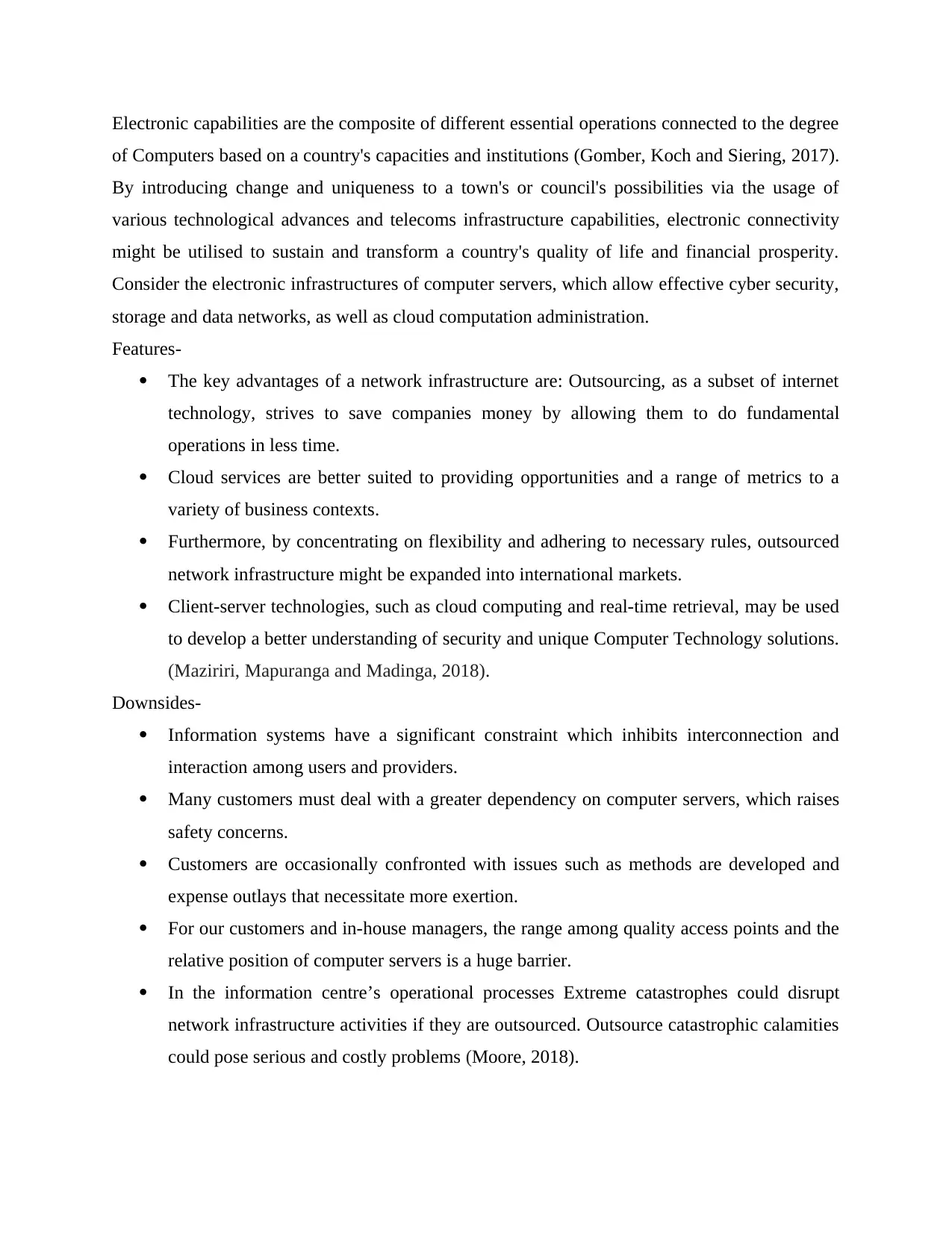
Electronic capabilities are the composite of different essential operations connected to the degree
of Computers based on a country's capacities and institutions (Gomber, Koch and Siering, 2017).
By introducing change and uniqueness to a town's or council's possibilities via the usage of
various technological advances and telecoms infrastructure capabilities, electronic connectivity
might be utilised to sustain and transform a country's quality of life and financial prosperity.
Consider the electronic infrastructures of computer servers, which allow effective cyber security,
storage and data networks, as well as cloud computation administration.
Features-
The key advantages of a network infrastructure are: Outsourcing, as a subset of internet
technology, strives to save companies money by allowing them to do fundamental
operations in less time.
Cloud services are better suited to providing opportunities and a range of metrics to a
variety of business contexts.
Furthermore, by concentrating on flexibility and adhering to necessary rules, outsourced
network infrastructure might be expanded into international markets.
Client-server technologies, such as cloud computing and real-time retrieval, may be used
to develop a better understanding of security and unique Computer Technology solutions.
(Maziriri, Mapuranga and Madinga, 2018).
Downsides-
Information systems have a significant constraint which inhibits interconnection and
interaction among users and providers.
Many customers must deal with a greater dependency on computer servers, which raises
safety concerns.
Customers are occasionally confronted with issues such as methods are developed and
expense outlays that necessitate more exertion.
For our customers and in-house managers, the range among quality access points and the
relative position of computer servers is a huge barrier.
In the information centre’s operational processes Extreme catastrophes could disrupt
network infrastructure activities if they are outsourced. Outsource catastrophic calamities
could pose serious and costly problems (Moore, 2018).
of Computers based on a country's capacities and institutions (Gomber, Koch and Siering, 2017).
By introducing change and uniqueness to a town's or council's possibilities via the usage of
various technological advances and telecoms infrastructure capabilities, electronic connectivity
might be utilised to sustain and transform a country's quality of life and financial prosperity.
Consider the electronic infrastructures of computer servers, which allow effective cyber security,
storage and data networks, as well as cloud computation administration.
Features-
The key advantages of a network infrastructure are: Outsourcing, as a subset of internet
technology, strives to save companies money by allowing them to do fundamental
operations in less time.
Cloud services are better suited to providing opportunities and a range of metrics to a
variety of business contexts.
Furthermore, by concentrating on flexibility and adhering to necessary rules, outsourced
network infrastructure might be expanded into international markets.
Client-server technologies, such as cloud computing and real-time retrieval, may be used
to develop a better understanding of security and unique Computer Technology solutions.
(Maziriri, Mapuranga and Madinga, 2018).
Downsides-
Information systems have a significant constraint which inhibits interconnection and
interaction among users and providers.
Many customers must deal with a greater dependency on computer servers, which raises
safety concerns.
Customers are occasionally confronted with issues such as methods are developed and
expense outlays that necessitate more exertion.
For our customers and in-house managers, the range among quality access points and the
relative position of computer servers is a huge barrier.
In the information centre’s operational processes Extreme catastrophes could disrupt
network infrastructure activities if they are outsourced. Outsource catastrophic calamities
could pose serious and costly problems (Moore, 2018).
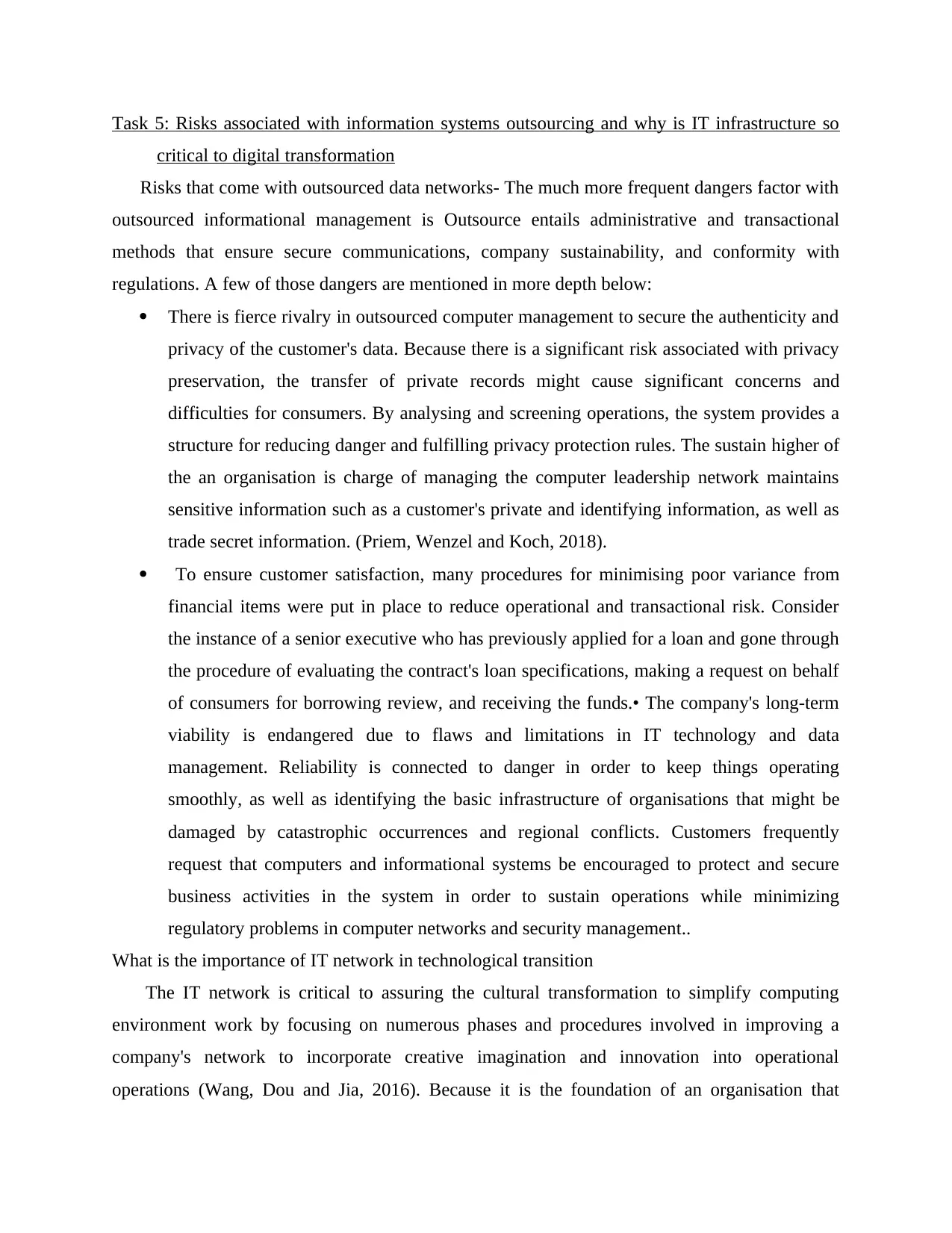
Task 5: Risks associated with information systems outsourcing and why is IT infrastructure so
critical to digital transformation
Risks that come with outsourced data networks- The much more frequent dangers factor with
outsourced informational management is Outsource entails administrative and transactional
methods that ensure secure communications, company sustainability, and conformity with
regulations. A few of those dangers are mentioned in more depth below:
There is fierce rivalry in outsourced computer management to secure the authenticity and
privacy of the customer's data. Because there is a significant risk associated with privacy
preservation, the transfer of private records might cause significant concerns and
difficulties for consumers. By analysing and screening operations, the system provides a
structure for reducing danger and fulfilling privacy protection rules. The sustain higher of
the an organisation is charge of managing the computer leadership network maintains
sensitive information such as a customer's private and identifying information, as well as
trade secret information. (Priem, Wenzel and Koch, 2018).
To ensure customer satisfaction, many procedures for minimising poor variance from
financial items were put in place to reduce operational and transactional risk. Consider
the instance of a senior executive who has previously applied for a loan and gone through
the procedure of evaluating the contract's loan specifications, making a request on behalf
of consumers for borrowing review, and receiving the funds.• The company's long-term
viability is endangered due to flaws and limitations in IT technology and data
management. Reliability is connected to danger in order to keep things operating
smoothly, as well as identifying the basic infrastructure of organisations that might be
damaged by catastrophic occurrences and regional conflicts. Customers frequently
request that computers and informational systems be encouraged to protect and secure
business activities in the system in order to sustain operations while minimizing
regulatory problems in computer networks and security management..
What is the importance of IT network in technological transition
The IT network is critical to assuring the cultural transformation to simplify computing
environment work by focusing on numerous phases and procedures involved in improving a
company's network to incorporate creative imagination and innovation into operational
operations (Wang, Dou and Jia, 2016). Because it is the foundation of an organisation that
critical to digital transformation
Risks that come with outsourced data networks- The much more frequent dangers factor with
outsourced informational management is Outsource entails administrative and transactional
methods that ensure secure communications, company sustainability, and conformity with
regulations. A few of those dangers are mentioned in more depth below:
There is fierce rivalry in outsourced computer management to secure the authenticity and
privacy of the customer's data. Because there is a significant risk associated with privacy
preservation, the transfer of private records might cause significant concerns and
difficulties for consumers. By analysing and screening operations, the system provides a
structure for reducing danger and fulfilling privacy protection rules. The sustain higher of
the an organisation is charge of managing the computer leadership network maintains
sensitive information such as a customer's private and identifying information, as well as
trade secret information. (Priem, Wenzel and Koch, 2018).
To ensure customer satisfaction, many procedures for minimising poor variance from
financial items were put in place to reduce operational and transactional risk. Consider
the instance of a senior executive who has previously applied for a loan and gone through
the procedure of evaluating the contract's loan specifications, making a request on behalf
of consumers for borrowing review, and receiving the funds.• The company's long-term
viability is endangered due to flaws and limitations in IT technology and data
management. Reliability is connected to danger in order to keep things operating
smoothly, as well as identifying the basic infrastructure of organisations that might be
damaged by catastrophic occurrences and regional conflicts. Customers frequently
request that computers and informational systems be encouraged to protect and secure
business activities in the system in order to sustain operations while minimizing
regulatory problems in computer networks and security management..
What is the importance of IT network in technological transition
The IT network is critical to assuring the cultural transformation to simplify computing
environment work by focusing on numerous phases and procedures involved in improving a
company's network to incorporate creative imagination and innovation into operational
operations (Wang, Dou and Jia, 2016). Because it is the foundation of an organisation that
⊘ This is a preview!⊘
Do you want full access?
Subscribe today to unlock all pages.

Trusted by 1+ million students worldwide
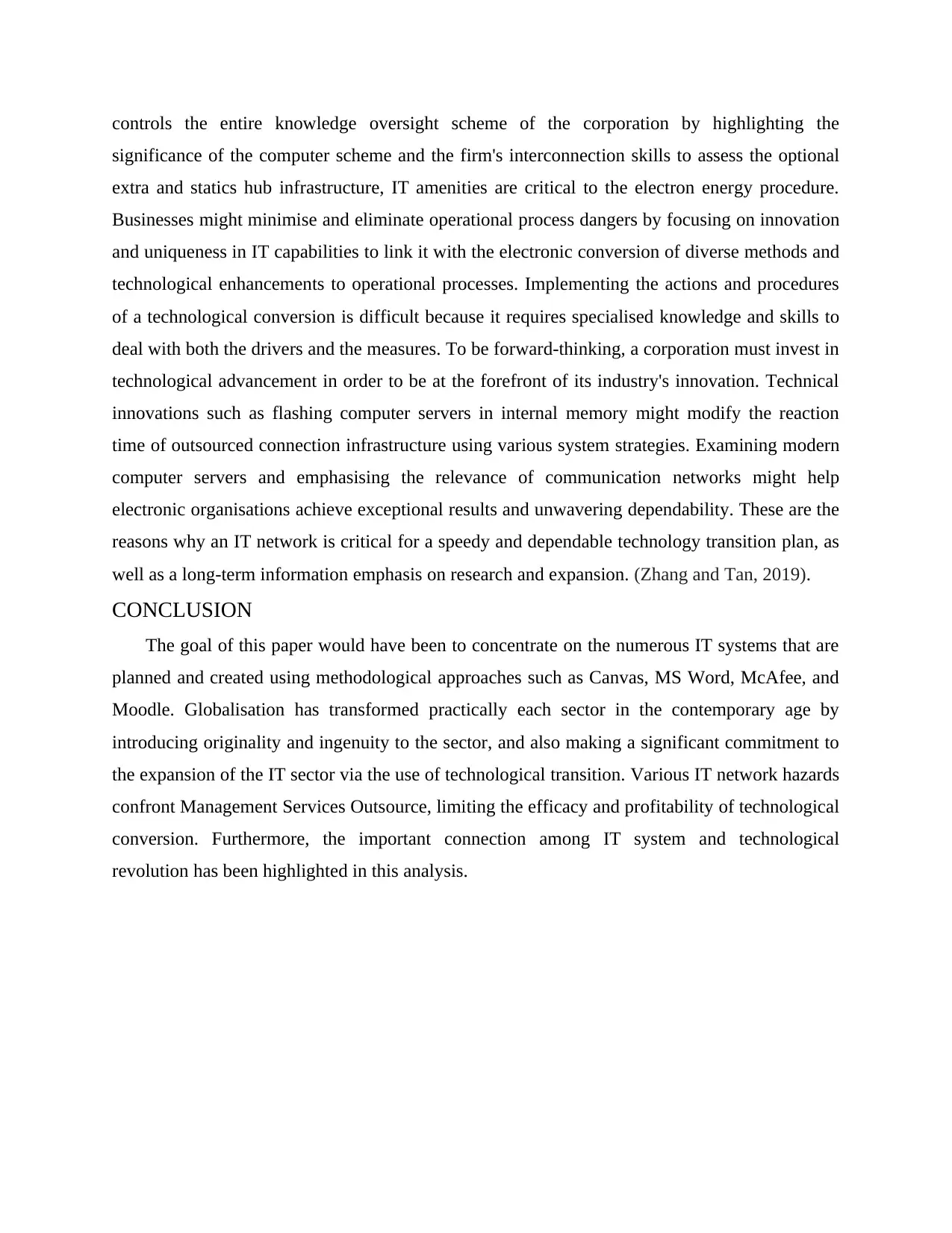
controls the entire knowledge oversight scheme of the corporation by highlighting the
significance of the computer scheme and the firm's interconnection skills to assess the optional
extra and statics hub infrastructure, IT amenities are critical to the electron energy procedure.
Businesses might minimise and eliminate operational process dangers by focusing on innovation
and uniqueness in IT capabilities to link it with the electronic conversion of diverse methods and
technological enhancements to operational processes. Implementing the actions and procedures
of a technological conversion is difficult because it requires specialised knowledge and skills to
deal with both the drivers and the measures. To be forward-thinking, a corporation must invest in
technological advancement in order to be at the forefront of its industry's innovation. Technical
innovations such as flashing computer servers in internal memory might modify the reaction
time of outsourced connection infrastructure using various system strategies. Examining modern
computer servers and emphasising the relevance of communication networks might help
electronic organisations achieve exceptional results and unwavering dependability. These are the
reasons why an IT network is critical for a speedy and dependable technology transition plan, as
well as a long-term information emphasis on research and expansion. (Zhang and Tan, 2019).
CONCLUSION
The goal of this paper would have been to concentrate on the numerous IT systems that are
planned and created using methodological approaches such as Canvas, MS Word, McAfee, and
Moodle. Globalisation has transformed practically each sector in the contemporary age by
introducing originality and ingenuity to the sector, and also making a significant commitment to
the expansion of the IT sector via the use of technological transition. Various IT network hazards
confront Management Services Outsource, limiting the efficacy and profitability of technological
conversion. Furthermore, the important connection among IT system and technological
revolution has been highlighted in this analysis.
significance of the computer scheme and the firm's interconnection skills to assess the optional
extra and statics hub infrastructure, IT amenities are critical to the electron energy procedure.
Businesses might minimise and eliminate operational process dangers by focusing on innovation
and uniqueness in IT capabilities to link it with the electronic conversion of diverse methods and
technological enhancements to operational processes. Implementing the actions and procedures
of a technological conversion is difficult because it requires specialised knowledge and skills to
deal with both the drivers and the measures. To be forward-thinking, a corporation must invest in
technological advancement in order to be at the forefront of its industry's innovation. Technical
innovations such as flashing computer servers in internal memory might modify the reaction
time of outsourced connection infrastructure using various system strategies. Examining modern
computer servers and emphasising the relevance of communication networks might help
electronic organisations achieve exceptional results and unwavering dependability. These are the
reasons why an IT network is critical for a speedy and dependable technology transition plan, as
well as a long-term information emphasis on research and expansion. (Zhang and Tan, 2019).
CONCLUSION
The goal of this paper would have been to concentrate on the numerous IT systems that are
planned and created using methodological approaches such as Canvas, MS Word, McAfee, and
Moodle. Globalisation has transformed practically each sector in the contemporary age by
introducing originality and ingenuity to the sector, and also making a significant commitment to
the expansion of the IT sector via the use of technological transition. Various IT network hazards
confront Management Services Outsource, limiting the efficacy and profitability of technological
conversion. Furthermore, the important connection among IT system and technological
revolution has been highlighted in this analysis.
Paraphrase This Document
Need a fresh take? Get an instant paraphrase of this document with our AI Paraphraser
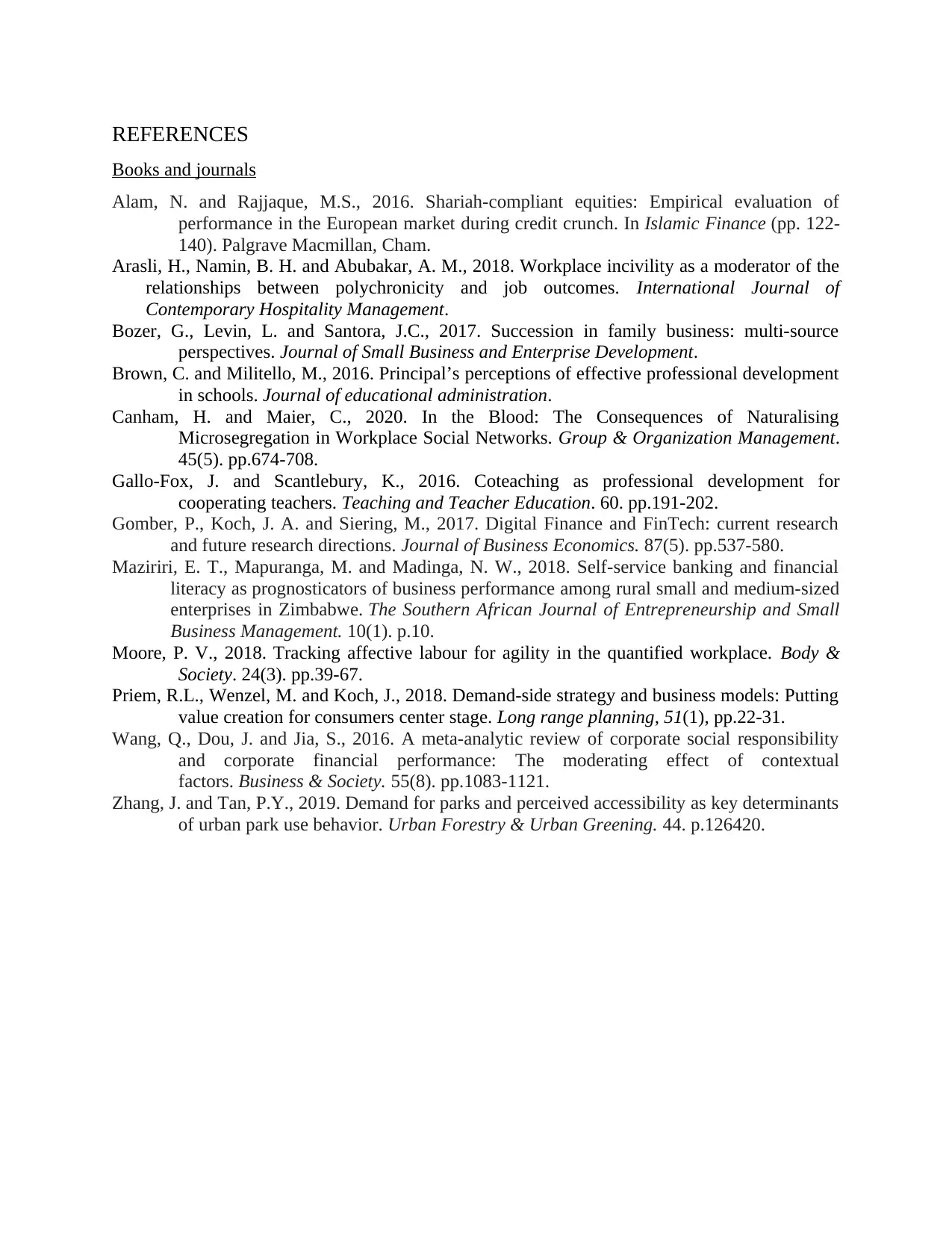
REFERENCES
Books and journals
Alam, N. and Rajjaque, M.S., 2016. Shariah-compliant equities: Empirical evaluation of
performance in the European market during credit crunch. In Islamic Finance (pp. 122-
140). Palgrave Macmillan, Cham.
Arasli, H., Namin, B. H. and Abubakar, A. M., 2018. Workplace incivility as a moderator of the
relationships between polychronicity and job outcomes. International Journal of
Contemporary Hospitality Management.
Bozer, G., Levin, L. and Santora, J.C., 2017. Succession in family business: multi-source
perspectives. Journal of Small Business and Enterprise Development.
Brown, C. and Militello, M., 2016. Principal’s perceptions of effective professional development
in schools. Journal of educational administration.
Canham, H. and Maier, C., 2020. In the Blood: The Consequences of Naturalising
Microsegregation in Workplace Social Networks. Group & Organization Management.
45(5). pp.674-708.
Gallo-Fox, J. and Scantlebury, K., 2016. Coteaching as professional development for
cooperating teachers. Teaching and Teacher Education. 60. pp.191-202.
Gomber, P., Koch, J. A. and Siering, M., 2017. Digital Finance and FinTech: current research
and future research directions. Journal of Business Economics. 87(5). pp.537-580.
Maziriri, E. T., Mapuranga, M. and Madinga, N. W., 2018. Self-service banking and financial
literacy as prognosticators of business performance among rural small and medium-sized
enterprises in Zimbabwe. The Southern African Journal of Entrepreneurship and Small
Business Management. 10(1). p.10.
Moore, P. V., 2018. Tracking affective labour for agility in the quantified workplace. Body &
Society. 24(3). pp.39-67.
Priem, R.L., Wenzel, M. and Koch, J., 2018. Demand-side strategy and business models: Putting
value creation for consumers center stage. Long range planning, 51(1), pp.22-31.
Wang, Q., Dou, J. and Jia, S., 2016. A meta-analytic review of corporate social responsibility
and corporate financial performance: The moderating effect of contextual
factors. Business & Society. 55(8). pp.1083-1121.
Zhang, J. and Tan, P.Y., 2019. Demand for parks and perceived accessibility as key determinants
of urban park use behavior. Urban Forestry & Urban Greening. 44. p.126420.
Books and journals
Alam, N. and Rajjaque, M.S., 2016. Shariah-compliant equities: Empirical evaluation of
performance in the European market during credit crunch. In Islamic Finance (pp. 122-
140). Palgrave Macmillan, Cham.
Arasli, H., Namin, B. H. and Abubakar, A. M., 2018. Workplace incivility as a moderator of the
relationships between polychronicity and job outcomes. International Journal of
Contemporary Hospitality Management.
Bozer, G., Levin, L. and Santora, J.C., 2017. Succession in family business: multi-source
perspectives. Journal of Small Business and Enterprise Development.
Brown, C. and Militello, M., 2016. Principal’s perceptions of effective professional development
in schools. Journal of educational administration.
Canham, H. and Maier, C., 2020. In the Blood: The Consequences of Naturalising
Microsegregation in Workplace Social Networks. Group & Organization Management.
45(5). pp.674-708.
Gallo-Fox, J. and Scantlebury, K., 2016. Coteaching as professional development for
cooperating teachers. Teaching and Teacher Education. 60. pp.191-202.
Gomber, P., Koch, J. A. and Siering, M., 2017. Digital Finance and FinTech: current research
and future research directions. Journal of Business Economics. 87(5). pp.537-580.
Maziriri, E. T., Mapuranga, M. and Madinga, N. W., 2018. Self-service banking and financial
literacy as prognosticators of business performance among rural small and medium-sized
enterprises in Zimbabwe. The Southern African Journal of Entrepreneurship and Small
Business Management. 10(1). p.10.
Moore, P. V., 2018. Tracking affective labour for agility in the quantified workplace. Body &
Society. 24(3). pp.39-67.
Priem, R.L., Wenzel, M. and Koch, J., 2018. Demand-side strategy and business models: Putting
value creation for consumers center stage. Long range planning, 51(1), pp.22-31.
Wang, Q., Dou, J. and Jia, S., 2016. A meta-analytic review of corporate social responsibility
and corporate financial performance: The moderating effect of contextual
factors. Business & Society. 55(8). pp.1083-1121.
Zhang, J. and Tan, P.Y., 2019. Demand for parks and perceived accessibility as key determinants
of urban park use behavior. Urban Forestry & Urban Greening. 44. p.126420.
1 out of 11
Related Documents
Your All-in-One AI-Powered Toolkit for Academic Success.
+13062052269
info@desklib.com
Available 24*7 on WhatsApp / Email
![[object Object]](/_next/static/media/star-bottom.7253800d.svg)
Unlock your academic potential
Copyright © 2020–2025 A2Z Services. All Rights Reserved. Developed and managed by ZUCOL.

